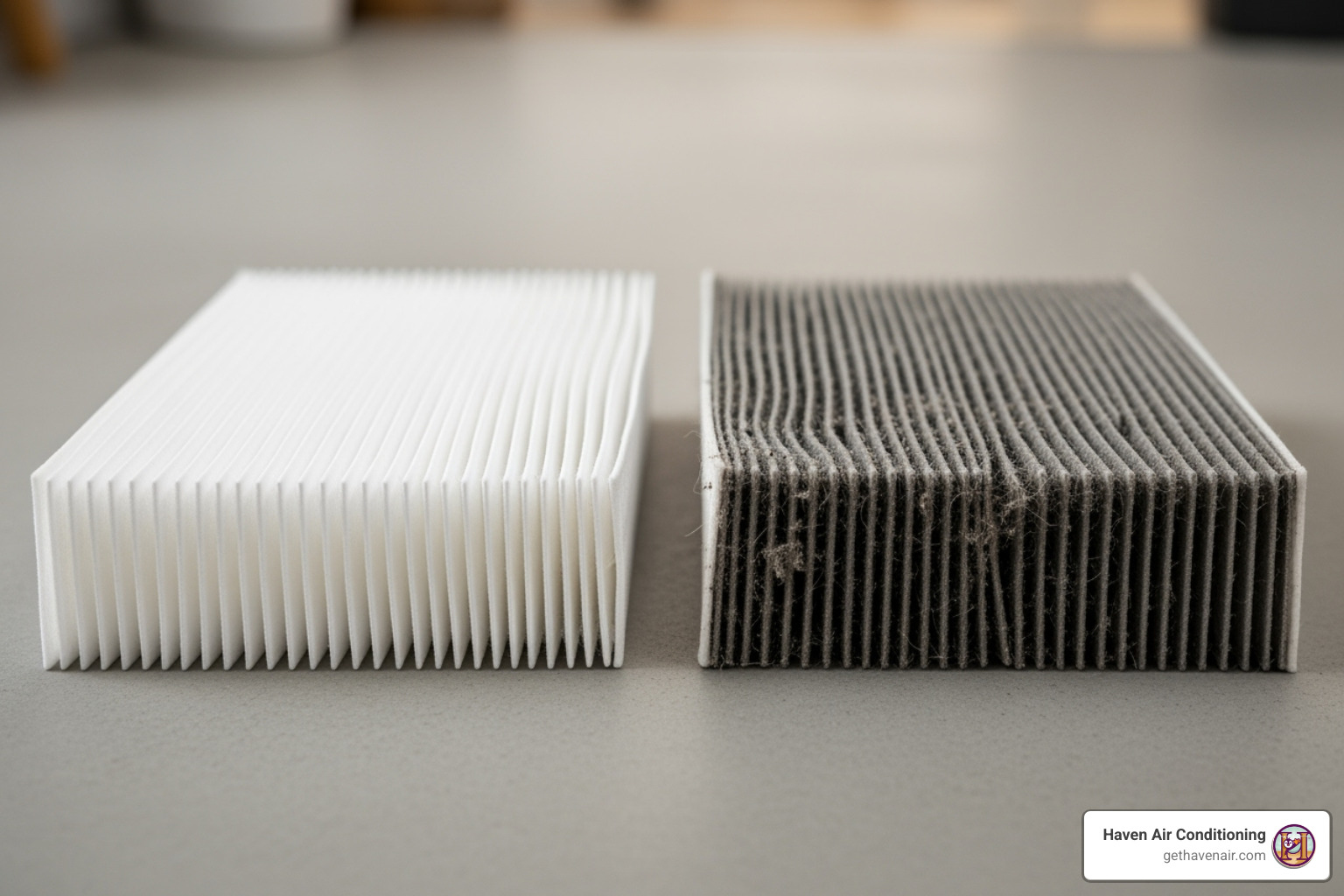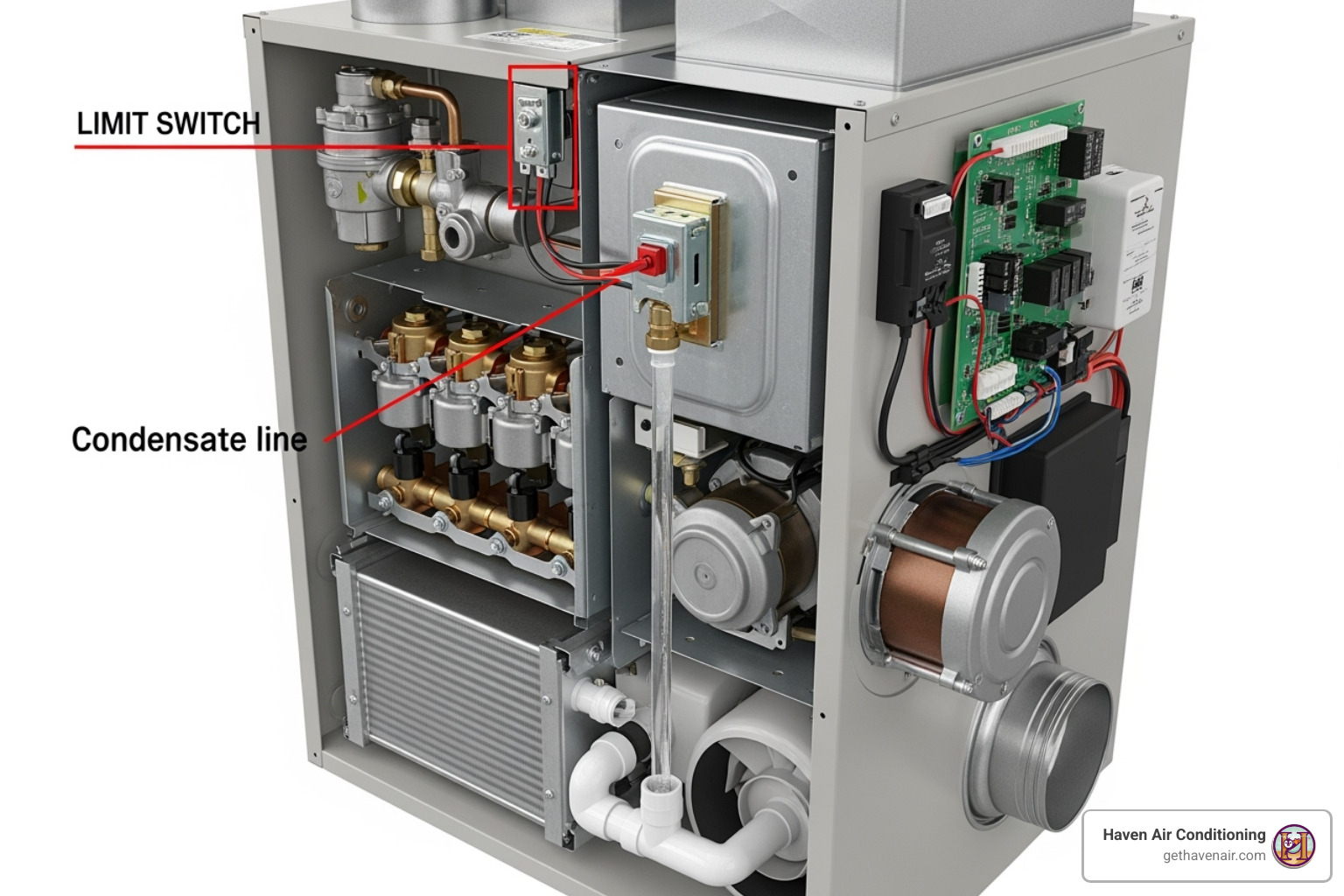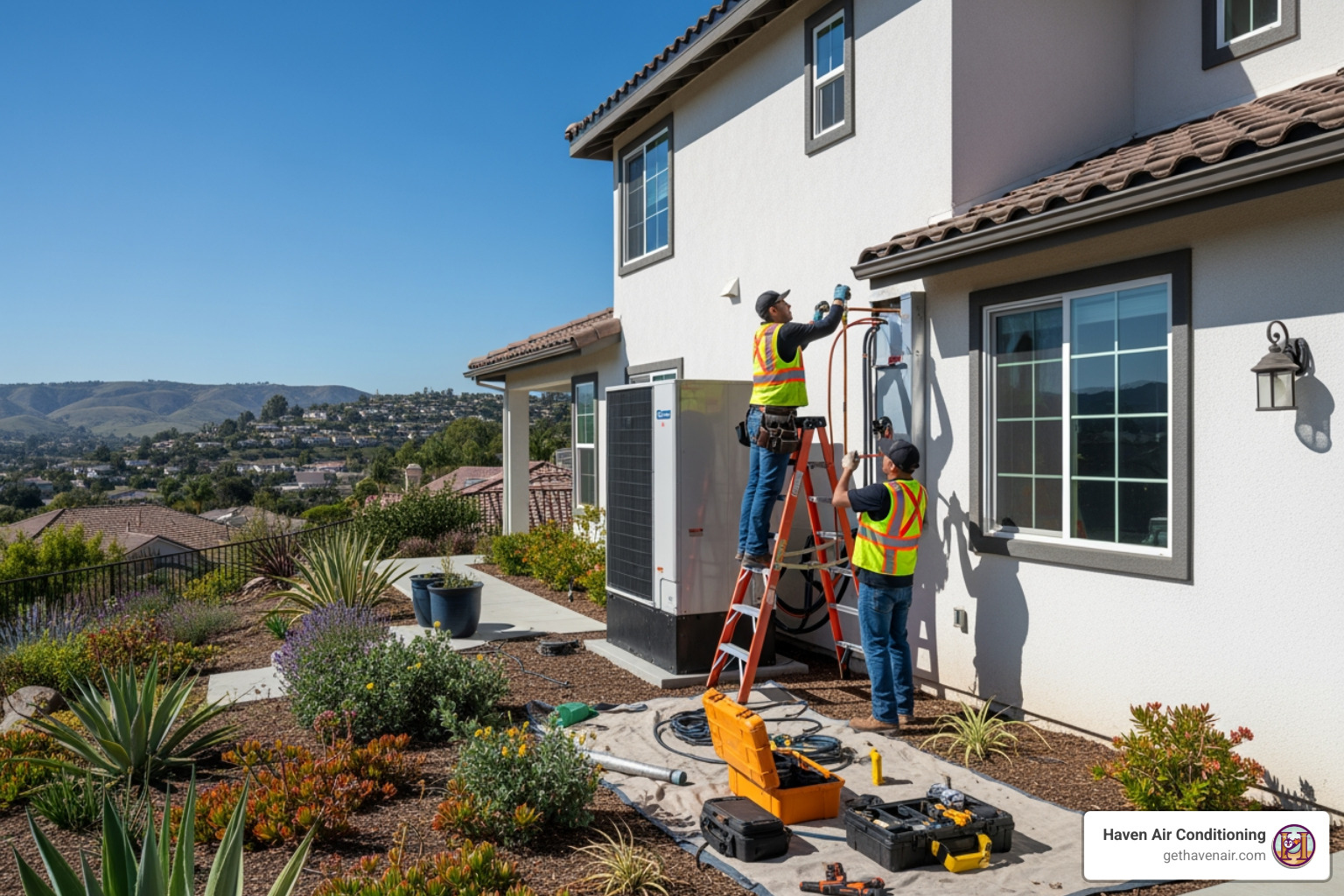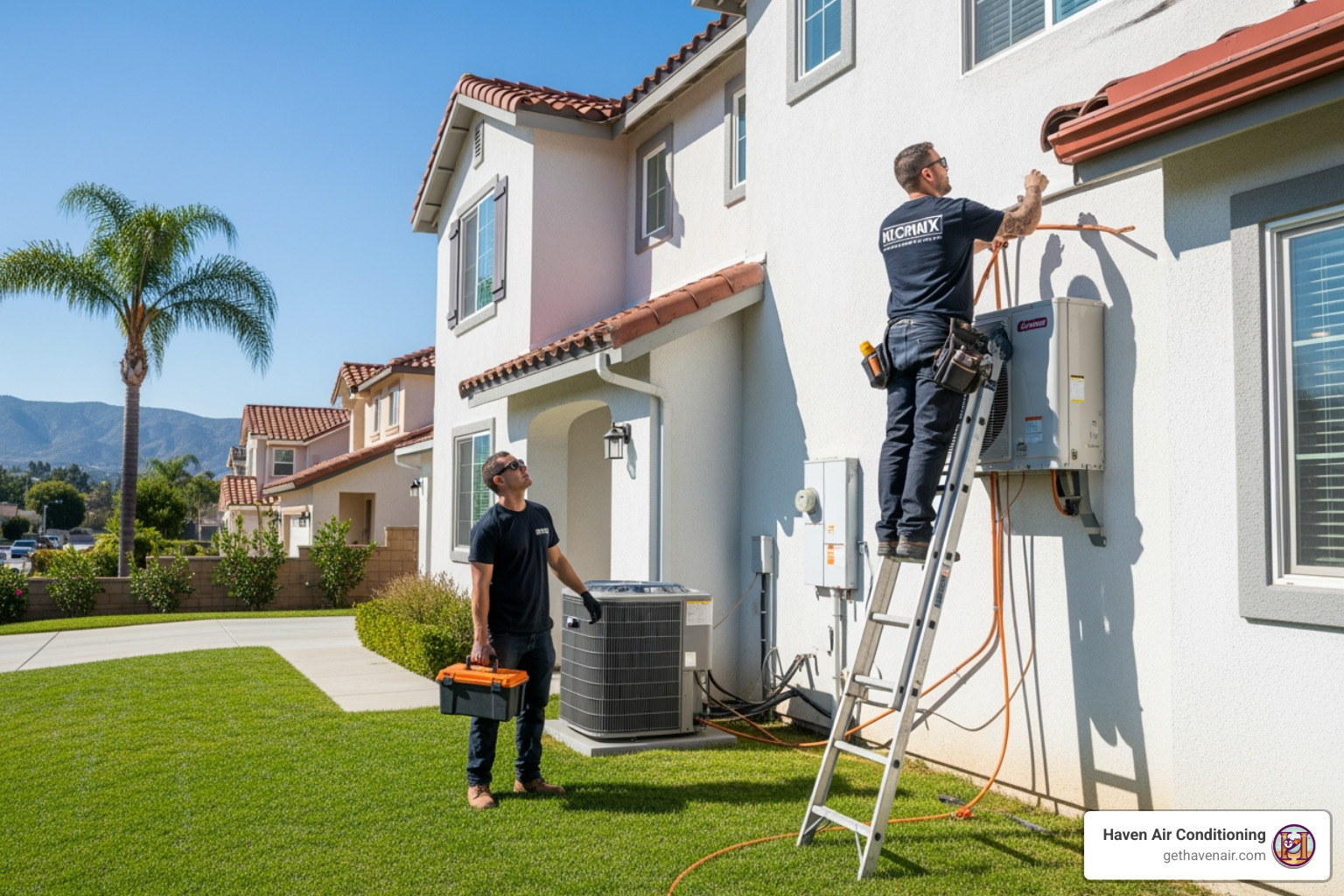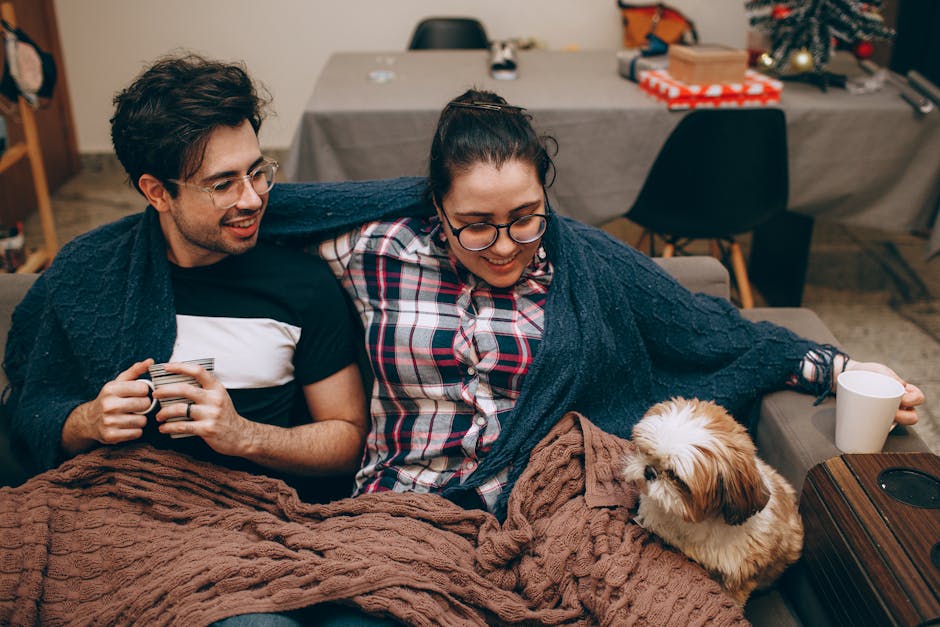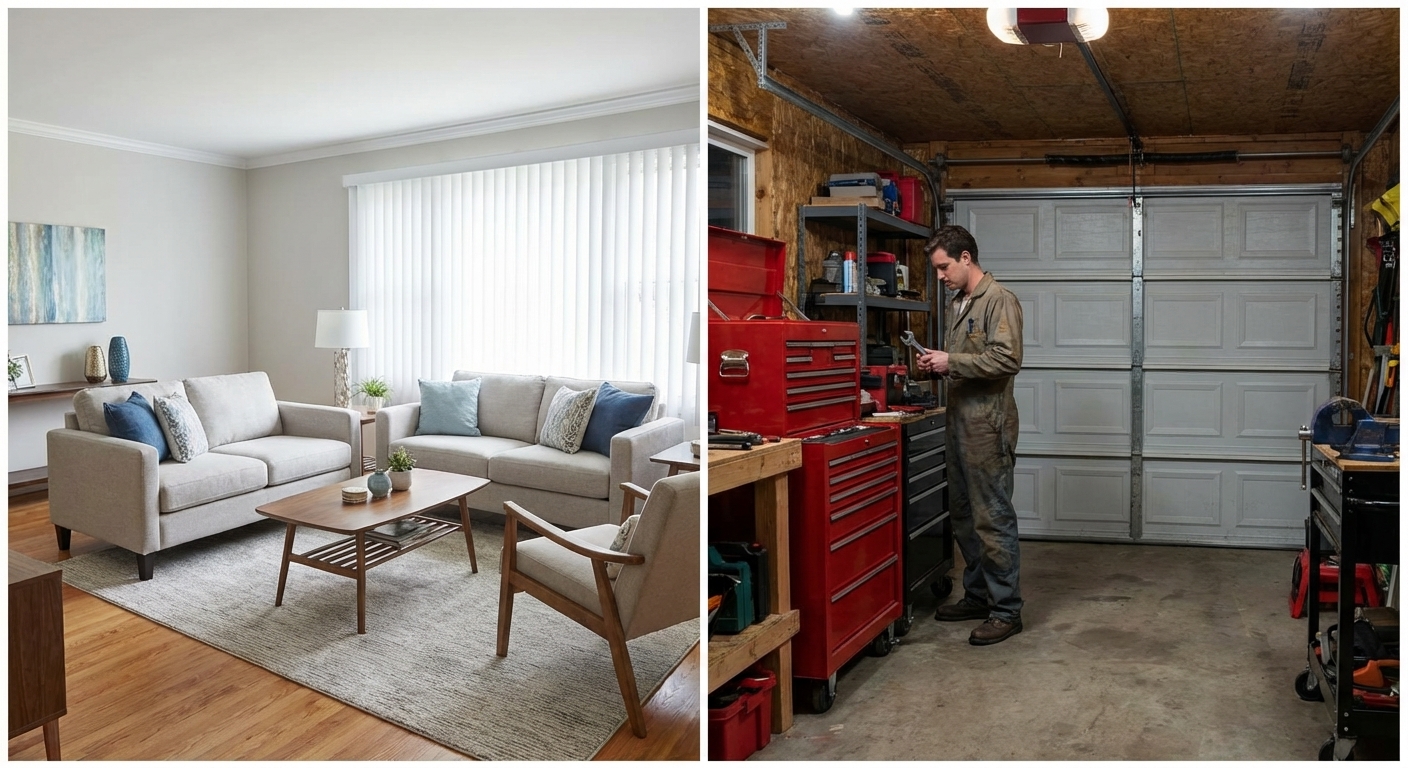When Your Home Heating System Fails You
A heater blowing cold air is a frustrating problem, especially during Orange County’s cooler months. When you expect warmth and get a chilly blast from your vents, it’s time to troubleshoot. Many causes have simple fixes you can handle yourself, while others require immediate professional attention for your safety.
Quick Checks for a Heater Blowing Cold Air:
- Thermostat: Is it set to “Heat” and the fan to “Auto”?
- Air Filter: A clogged filter can cause a safety shutdown.
- Power: Check your circuit breaker and the furnace’s power switch.
- Vents: Ensure they are open and not blocked by furniture.
The most common culprits are incorrect thermostat settings, a dirty air filter, or a tripped circuit breaker. However, more serious issues like a faulty gas valve or a cracked heat exchanger demand an expert’s help.
Understanding why your heater blows cold air helps you know when to DIY and when to call a pro. This guide will walk you through basic troubleshooting for furnaces, heat pumps, and other heaters, so you can get back to being warm and comfortable.
Initial DIY Checks: Simple Fixes for a Heater Blowing Cold Air
Before calling for service, perform these simple checks. The most common reasons for a heater blowing cold air are often the easiest to fix, potentially saving you a service call.
Check Your Thermostat Settings First
An incorrect thermostat setting is a frequent cause of cold air from vents. First, ensure it’s set to “Heat.” If it’s on “Cool” or “Fan Only,” it will circulate unheated air.
Next, check the fan setting. The “On” setting makes the blower run continuously, even when the furnace isn’t heating. This pushes cool air through the vents between heating cycles. Switch the fan to “Auto” so it only runs when delivering warm air.
For digital thermostats, weak or dead batteries can cause malfunctions. Replacing them is an easy first step. Also, review any programmed schedules to ensure they haven’t been accidentally changed, which could affect when your heat turns on. If you have persistent thermostat issues, it might be one of the Signs Your System Needs HVAC Repair Services.
Inspect Your Air Filter and Vents
A dirty air filter is a primary cause of heating problems. When clogged with dust and debris, it severely restricts airflow. This can cause the furnace to overheat, triggering a safety switch that shuts down the burners. The fan may continue to run, but it will only blow cold air. This strain can impact the entire HVAC system.
Check your furnace filter monthly and replace it every 1-3 months, or more often if you have pets or allergies. This simple DIY task costs less than $35 and is crucial for proper operation.
While checking the filter, inspect your air vents. Make sure all supply and return vents are open and unobstructed by furniture, rugs, or other items. Blocked vents prevent warm air from circulating, making it feel like your furnace isn’t working correctly.
Basic System Resets
Sometimes, your system just needs a reset. Check your home’s circuit breaker box and find the breaker for your furnace or HVAC system. Flip it completely off, then back on. This can resolve minor electrical glitches.
For older gas furnaces, the pilot light may have gone out. If you have a standing pilot light, consult your owner’s manual for instructions on how to relight it safely. Modern furnaces use electronic ignition and don’t have a pilot light.
Finally, ensure the gas valve to your furnace is in the “On” or “Open” position. It can sometimes be turned off accidentally during other maintenance.
Why Is My Furnace Blowing Cold Air? Common Furnace Failures
If basic troubleshooting doesn’t solve the problem, your heater blowing cold air is likely due to a component failure inside the furnace. Understanding these potential issues can help you communicate with an HVAC professional. Many of these problems are repairable, and catching them early prevents more expensive damage. For more details, see our guide on Common Furnace Problems.
Ignition, Sensor, and Fuel Supply Problems
Your furnace’s ignition system is critical for generating heat. In older furnaces, a faulty thermocouple can cause the pilot light to go out repeatedly. The thermocouple is a safety device that shuts off gas if it doesn’t sense a flame. When it fails, the furnace won’t stay lit.
Modern furnaces use an electronic ignition and a flame sensor. This sensor confirms a flame is present after ignition. Over time, soot can coat the sensor, preventing it from detecting the flame. The furnace will then ignite for a few seconds before shutting the burners off, while the fan continues to run and blow cold air. Cleaning the flame sensor can often resolve this.
Gas supply issues, such as low pressure or a closed valve, can also prevent your furnace from heating. If you suspect a gas leak, it requires immediate Furnace Repair: Ensure Safe Home Heating.
Overheating, Airflow, and Drainage Issues
Surprisingly, a furnace can blow cold air because it’s overheating. This is usually caused by restricted airflow from a dirty filter. A safety device called the limit switch shuts down the burners to prevent damage, but the fan keeps running to cool the unit, circulating unheated air. A faulty limit switch can also cause this issue even when temperatures are normal.
High-efficiency furnaces produce condensation that must drain away. If the condensate line gets clogged with debris or freezes, a safety switch will shut down the furnace. You can sometimes clear minor clogs yourself, but persistent blockages require a professional.
Leaky air ducts can also be the culprit. If your ductwork has holes or gaps, a significant amount of heated air can escape into your attic or crawlspace before it ever reaches your rooms, making it feel like your heater is blowing cold air.
Critical Component Failures
Some furnace problems are serious and require immediate professional service. A cracked heat exchanger is the most dangerous, as it can leak dangerous carbon monoxide into your home (see carbon monoxide poisoning). Signs include strange smells, soot near the furnace, or yellow, flickering burner flames. If you notice these, turn off your furnace and call a professional immediately.
Other critical failures include a malfunctioning circuit control board (the furnace’s brain) or blower motor issues. These complex electrical and mechanical problems should always be diagnosed and repaired by a qualified technician. If you’ve checked the basics and still have issues, these might be Signs You Need Expert Furnace Repair.
What If It’s Not a Furnace? Issues with Heat Pumps and Other Heaters
Not all homes use a furnace. Heat pumps, electric heaters, and even car heaters can also blow cold air. Each system has unique reasons for failing, and our professionals are experienced with all HVAC Repair Techniques by Our Professionals.
Why is My Heat Pump Blowing Cold Air?
Heat pumps pull heat from the outside air. Sometimes, they blow cool air for a few minutes as part of their normal operation—this is called defrost mode. When ice builds up on the outdoor coil, the system temporarily reverses to melt it, which can last for 5-10 minutes. This is normal.
However, if the cold air is constant, you may have a problem. A faulty reversing valve can get stuck in cooling mode. Low refrigerant levels due to a leak also prevent the system from heating effectively. Refrigerant issues require a certified technician to repair the leak and recharge the system. For more details, see our guide: Why is my Heat Pump Blowing Cold Air?.
Troubleshooting a Car Heater Blowing Cold Air
When your car heater fails, the commute can be miserable. The most common causes include:
- Low Coolant Level: Your car’s heater uses hot coolant from the engine. If the level is low, there isn’t enough hot fluid to warm the cabin.
- Faulty Car Thermostat: If the thermostat is stuck open, the engine won’t reach the proper temperature, and the air from your vents will stay cool.
- Clogged Heater Core: A blockage in the small radiator in your dashboard can prevent heat transfer. A sweet smell inside the car is a common sign of a leak.
- Jammed Blend Door: This flap directs air, and if it’s stuck in the wrong position, you’ll only get cold air. This often requires professional repair.
Fixing an Electric Wall Heater
Electric wall heaters are simpler but can still fail. If yours is blowing cold air, try these steps:
- Check the Reset Button: Many units have a manual reset button that trips if the heater overheats, often due to dust or a blockage. Turn off the power at the breaker before pressing it.
- Verify the Setting: Ensure the heater isn’t on a “fan-only” setting.
- Check for Serious Issues: A defective heating element or loose wiring will prevent the unit from producing heat. These are electrical repairs best left to a professional. If you see sparks, smell burning, or the breaker keeps tripping, turn the unit off and call for help immediately.
DIY vs. Professional Repair: When to Call an Expert
When your heater blowing cold air strikes, it’s smart to know when to handle a fix yourself and when to call a professional. While simple checks can save you money, some repairs require specialized tools and knowledge to ensure safety and protect your HVAC system.
The Value of Regular Maintenance
Regular maintenance is the best way to prevent heater emergencies. An annual tune-up allows a technician to spot and fix small issues before they become major, expensive breakdowns. Professional maintenance also improves energy efficiency, lowering your utility bills, and can significantly extend your system’s lifespan. Our Heating Services are designed to provide peace of mind and keep your home comfortable.
Knowing Your Limits: When to Call for Help
Basic tasks like changing a filter are great for DIY, but certain situations demand professional expertise. Your safety is the top priority. Call for help immediately if you smell gas, suspect a carbon monoxide leak, or encounter complex electrical issues. Refrigerant leaks in heat pumps also require a certified technician.
If you’ve tried basic troubleshooting and your heater is still blowing cold air, it’s time for a professional diagnosis. Our technicians use specialized equipment to pinpoint the exact cause, saving you time and preventing unnecessary repairs.
| DIY Tasks | Professional Repairs |
|---|---|
| Check/Replace Air Filter | Diagnose/Repair Faulty Limit Switch |
| Adjust Thermostat Settings | Recharge Refrigerant (Heat Pump) |
| Reset Circuit Breaker | Repair/Replace Cracked Heat Exchanger |
| Relight Pilot Light (if comfortable) | Replace Faulty Circuit Control Board |
| Clear Blocked Vents | Repair/Replace Blower Motor or Components |
| Clear Simple Condensate Line Clogs | Address Complex Gas Supply Issues |
When complex repairs are needed, it’s Time for Furnace Repair by Experts. Our certified professionals at Haven Air Conditioning are ready to help.
Frequently Asked Questions about Heaters Blowing Cold Air
When your heater blowing cold air becomes a problem, you likely have questions. Here are answers to the most common concerns we hear from homeowners.
How do I know if my furnace’s flame sensor is the problem?
A classic sign of a faulty flame sensor is when your furnace ignites for a few seconds, then the burners shut off unexpectedly. This cycle may repeat multiple times. The sensor, a thin metal rod near the burners, is likely dirty and needs to be cleaned by a professional to properly detect the flame.
Can a dirty air filter really cause my heater to blow cold air?
Yes, absolutely. A severely clogged filter restricts airflow, causing the furnace to overheat. A safety feature called the limit switch will then shut off the burners to prevent damage. The fan, however, may continue to run, circulating unheated air through your vents. Replacing the filter is a simple fix that often solves the problem.
Is it normal for my heat pump to blow cool air sometimes?
Yes, it can be normal. Heat pumps occasionally enter a “defrost mode” to melt ice off the outdoor unit. During this cycle, which lasts about 5-15 minutes, the system temporarily reverses, and you may feel cooler air. If the cool air is brief and the system returns to heating, it’s working correctly. If the air stays cold for longer, you likely have an issue that needs professional attention.
Stay Warm with Reliable Heater Solutions
No one should have to deal with a heater blowing cold air. While a faulty heating system is frustrating, you now have the knowledge to handle many common issues yourself.
Always start with the basics: check your thermostat, replace the air filter, and reset the circuit breaker. These simple steps solve a majority of heating problems.
However, know when to call for professional help. If you smell gas, suspect a carbon monoxide leak, or face persistent electrical problems, your safety comes first. Turn off the system and contact an expert.
Regular maintenance is the best defense against unexpected breakdowns. Annual tune-ups keep your system efficient and reliable, preventing small issues from turning into major headaches.
For residents throughout Orange County, from Anaheim to Irvine, Haven Air Conditioning is here to ensure your comfort can’t wait. Our certified professionals combine technical expertise with exceptional customer service.
If your heater blowing cold air problem continues, or you’d prefer an expert to handle it, we’re here to help. Sometimes, the best DIY decision is knowing when to call the pros.
Schedule your heater repair today and get back to enjoying a warm, comfortable home.



